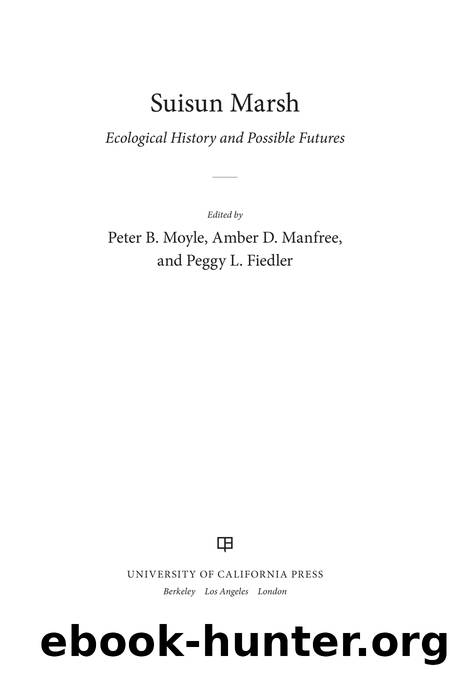Suisun Marsh: Ecological History and Possible Futures by Peter B. Moyle Amber D. Manfree & Peggy L. Fiedler

Author:Peter B. Moyle, Amber D. Manfree & Peggy L. Fiedler
Language: eng
Format: epub
ISBN: 9780520276086
Publisher: University of California Press
OVERVIEW: BREEDING WATERFOWL
Waterfowl are highly migratory, and most waterfowl that winter within the United States originate from breeding grounds in Alaska and Canada. California is unique among wintering areas for North American waterfowl, in that a large percentage of mallard, gadwall, and cinnamon teal are produced locally on breeding grounds within the state. In fact, over 60% of mallard harvested in California originate in California; the remaining birds originate from Oregon, Washington, British Columbia, Alberta, Alaska, and the Yukon Territory (Munro and Kimball 1982; Ackerman et al. 2010).
The breeding population index of dabbling ducks in California has averaged 562,000 ducks, of which 364,000 are mallard, since the annual breeding population survey8 was established in 1992 (figure 5.5). In addition to mallard (62%), these ducks include gadwall (15%), cinnamon teal (8%), shoveler (6%), wood duck (1%), and pintail (1%). On average, 5% of Californiaâs surveyed mallard and 7% of gadwall breed in Suisun Marsh. The larger areas in the Sacramento Valley (36%), northeastern California (25%), and San Joaquin grasslands (16%) support the majority of mallard (other areas are East Valley, 6%; San Joaquin desert, 4%; Napa marshes, 4%; San Francisco Bay and SacramentoâSan Joaquin Delta, 2%; and West Valley, 2%).9
The proportions of mallard and gadwall breeding in Suisun Marsh in relation to their statewide breeding populations have declined significantly since 1992 (figure 5.5). Nevertheless, breeding densities of ducks in Suisun Marsh are still among the highest in the state. The Marsh is considered a hot spot for high nesting densities, even compared with more traditional nesting areas in North America such as the Prairie Pothole Region in the central United States and Canada. In addition to occurring in high nesting densities, ducks in Suisun Marsh also tend to initiate nesting attempts earlier in the breeding season than elsewhere in North America, thus yielding more opportunities for hens to produce a successful clutch during the summer (McLandress et al. 1996; Krapu et al. 2002).
One of the worldâs longest-running studies on nesting ecology of ducks has been conducted annually in Suisun Marsh since 1985 at the Grizzly Island Wildlife Area (Ackerman et al. 2009). The majority of breeding ducks are mallard (75%), gadwall (17%), pintail (5%), cinnamon teal (2%), and shoveler (1%). However, in recent years the proportion of nesting mallard has been much lower (60%), while the proportion of gadwall (33%) has increased. This upland habitat used for nesting by ducks also is used for nesting by northern harriers, short-eared owls, American bittern, ring-necked pheasant, and numerous songbirds. The study documented a dramatic increase in dabbling duck nesting density, up to 16 nests/ha, followed by a precipitous decline (Ackerman et al. 2009). The decline in duck productivity may be associated with upland vegetation quality. In the 1980s and early 1990s, the California Department of Fish and Game actively managed vegetation in several of the fields by planting various mixes of tall wheat grass (Elymus ponticus), vetch (Vicia spp.), alfalfa (Medicago sativa), perennial rye grass (Festuca spp.), and wheat (Elymus spp.) that produced high-quality, dense nesting cover for ducks.
Download
This site does not store any files on its server. We only index and link to content provided by other sites. Please contact the content providers to delete copyright contents if any and email us, we'll remove relevant links or contents immediately.
| Anatomy | Animals |
| Bacteriology | Biochemistry |
| Bioelectricity | Bioinformatics |
| Biology | Biophysics |
| Biotechnology | Botany |
| Ecology | Genetics |
| Paleontology | Plants |
| Taxonomic Classification | Zoology |
Sapiens: A Brief History of Humankind by Yuval Noah Harari(14252)
The Tidewater Tales by John Barth(12608)
Mastermind: How to Think Like Sherlock Holmes by Maria Konnikova(7227)
Do No Harm Stories of Life, Death and Brain Surgery by Henry Marsh(6891)
The Thirst by Nesbo Jo(6828)
Why We Sleep: Unlocking the Power of Sleep and Dreams by Matthew Walker(6618)
Life 3.0: Being Human in the Age of Artificial Intelligence by Tegmark Max(5474)
Sapiens by Yuval Noah Harari(5294)
The Longevity Diet by Valter Longo(5021)
The Body: A Guide for Occupants by Bill Bryson(4974)
The Rules Do Not Apply by Ariel Levy(4861)
The Immortal Life of Henrietta Lacks by Rebecca Skloot(4526)
Animal Frequency by Melissa Alvarez(4395)
Why We Sleep by Matthew Walker(4361)
The Hacking of the American Mind by Robert H. Lustig(4318)
Yoga Anatomy by Kaminoff Leslie(4306)
All Creatures Great and Small by James Herriot(4233)
Double Down (Diary of a Wimpy Kid Book 11) by Jeff Kinney(4207)
Barron's AP Biology by Goldberg M.S. Deborah T(4099)
